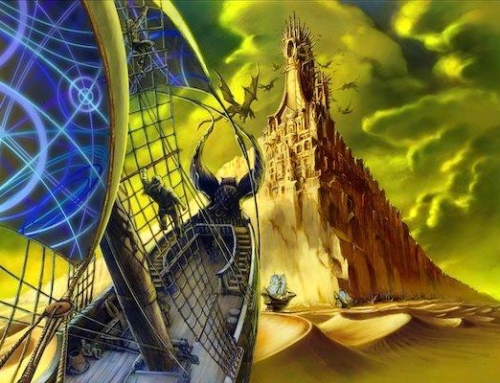
For a while now, something’s bugged me about the Hard/Soft Magic metric in fantasy. It’s a fairly simple metric in theory ⏤ hard magic systems involve strict rules and reader understanding of how the magic works, while soft magic systems are more obscure, meant to create a sense of wonder in the reader.
For the most part, Brandon Sanderson did a great job coming up with this metric. It’s relatively easy to fit most magic systems in somewhere along this scale. (Mage Errant fits in fairly close to the hard magic end of things ⏤ though there is plenty of magic that the reader doesn’t understand, but they can be assured that there are still consistent rules behind it, just ones the characters and the readers haven’t learned.)
The problem I’ve been having, though?
A Wizard of Earthsea.
Or, rather, truename magic systems like the one LeGuin used in Earthsea. I legitimately couldn’t say how many times I’ve heard claims for it being located on both ends of the magic hardness scale. Some people seem to fervently believe it’s soft magic (it certainly inspires an incredible sense of wonder), while others are quite firm in labeling it as hard magic (thanks to its logical, consistent rules).
Part of this confusion is certainly earned, of course. Any formalistic metric applied to art will of necessity be less than entirely rigorous, because, well, art is messy. On top of that, LeGuin could probably inspire wonder with near any type of magic system she chose to write ⏤ her prose and imagery are just that brilliant. Then there’s the Taoism bit ⏤ the Earthsea magic system was heavily inspired by Taoism, which, if you know anything about Taoism, definitely helps muddy the waters there a bit.
The problem, however, doesn’t just end with Earthsea’s truename magic system ⏤ it’s present to varying degrees in just about every other truename magic system I’ve ever encountered. (Cristopher Paolini’s Eragon series, Patrick Rothfuss’ The Name of the Wind, etc.) They often feel like soft magic systems, but they have pretty clearcut, delineated rules.
This goes beyond the common hybrid problem with hard/soft magic. It’s pretty common for people to have trouble pointing out where exactly on the scale a magic system goes, because very few magic systems are entirely either hard or soft, but somewhere in between. Many people, however, far prefer labeling a magic system as one or the other. This results in an inevitable rash of minor arguments, which I definitely enjoy. The problem with truename magic systems isn’t addressed by the idea of hybrid systems either, so far as I can tell.
I looked for an answer inside the hard/soft magic metric for a long time, because I’m a big nerd, and am also unnecessarily addicted to formalist examinations of my preferred art forms. Somewhat frustratingly, I didn’t have any particular luck there.
So, to my delight, it was time to construct a whole different metric: Platonic/emergent magic.
Platonic magic refers to Plato’s Ideal Forms, while Emergent magic refers to the systems theory idea of emergence. Or, if you don’t want to read through their Wikipedia articles:
- In this context, Platonic magic operates via Ideal Forms. Let’s use fire magic as an example. Essentially, fire magic works in reference to some ideal version of fire ⏤ a spell produces or knows what fire is because somewhere exists the prototype of fire, and it checks any other fire against that prototype. Or, alternatively, fire gives off some sort of resonance, signal, or other essence that identifies it as fire. Either way, there’s some meaning to fire (or whatever substance or phenomena that the magic affects) that exists above the corrupting mundanity of the physical world, outside of the changing forces of time.
- Emergent magic has none of that. Fire magic doesn’t recognize or produce fire because it has some fundamental natures as fire, it checks for abrupt increases in temperature, or smoke, or it creates fire by just increasing temperature drastically. Emergent magic, rather than referencing any sort of higher meaning, merely interacts with the various physical properties and processes of the universe.
I am, to be sure, taking some liberties with both ideal forms and emergence here, but since we’re talking about magic in fantasy novels, I hope you’ll forgive me said liberties.
Truename magic is, for the most part, entirely on the Platonic end of this scale. There’s a little play here, of course ⏤ some truename systems are a little more mutable than others. (In some truename systems, like the Dresden Files, the true names of humans can change over time.) Earthsea, Eragon, and the naming system from Name of the Wind are fit well into the Platonic end of things.
True name systems are hardly the only Platonic magic, of course. Almost every elemental magic system out there is Platonic as well. If you’ve got that standard set of four or more elements (earth, air, fire, water, wood, metal, sometimes other stuff like light, dark, spirit, etc), that’s pretty straightforwardly Platonic. It’s very clearly delineated in almost all of these systems what powers belong to what element, and they often have spiritual aspects to each.
I say almost every elemental magic system because I designed the magic system in Mage Errant specifically to be an emergent elemental system ⏤ I’ve been thinking about these ideas since well before I started writing Mage Errant. (Plus, there’s probably other emergent elemental magic systems I don’t know about.) I won’t go into more detail there, because I’m going to be going into that in the books.
Interestingly, Lovecraftian horror also counts as Platonic ⏤ though its ideal forms kinda drive you horribly mad. Also, the shadows cast in the Lovecraftian Allegory of the Cave are trying to eat your soul.
On the Emergent end of the scale, you have books like N.K. Jemisin’s Broken Earth trilogy, Brent Week’s Lightbringer series, or Barbara Hambly’s Darwath trilogy. Jemisin’s orogenes, mages with immense geological power, make a ton of sense as emergent mages ⏤ once you’ve taken a mineralogy or petrology class, the idea of ideal platonic forms of rocks actually existing is pretty laughable. Not the funny type of laughter, the really stressed out laughter you get trying to identify weird rocks for a test kind of laughter, because rocks are basically just statistical averages of mineral distributions and (muffled screaming). Geology, as arguably the least pure science (every “geological” force is just applied physical, chemical, or biological force), is fairly anathmetical to ideal forms ⏤ so it makes sense that geological magic developed with the kind of intense research Jemisin did would be Emergent magic.
Weeks’ Lightbringer series, at first glance, seems like it should be a Platonic magic system, but its system of color magic is based in a physics based understanding of color ⏤ each color being a specific range of the electromagnetic spectrum we see as visible light. On top of that, there’s no real reason that we label the beginning or end of a color’s range on the spectrum where they are other than our brains liking to chunk the endpoints where they are ⏤ something that, incidentally, varies somewhat from person to person, and can actually change over time. (When you learn new words for colors, you actually start physically differentiating new colors! Super cool stuff.) Definitely an emergent magic system.
Hambly’s Darwath magic I won’t go into too much detail on, but it at first seems like a pretty classical soft magic system (and it is), one that superficially seems Platonic at first, but it eventually turns out it’s actually an evolutionary response to a particular predator of humanity’s. Most of the Platonic features of the magic system are somewhat implied to be flawed medieval human understandings of how the whole system works. (If you’ve never read this series ⏤ which tragically few people do these days ⏤ read it as soon as you humanly can. Hambly is amazing.)
So here we have a whole new way of classifying magical systems, separate from the hard/soft magic classification, and it has essentially zero problems with truename magic systems. There’s no problem with an emergent system being either hard or soft, or a Platonic system being either hard or soft. (I do suspect, however, that if you were to actually make a representative spreadsheet, emergent systems would be moderately more likely to be hard magic, but not by a lot. I don’t suspect there would be a strong bias either way for Platonic magic.)
There are still a lot of kinks to work out here, of course ⏤ many systems are still pretty tough to categorize on it. Sygaldry, from The Name of the Wind, I keep bouncing back and forth on. Many of Brandon Sanderson’s magic systems seem to defy easy placement as well ⏤ I suspect in part because they tend to be just so far to the hard magic end of things that it drowns out the new scale entirely. Take Stormlight Archive surgebinding, for example ⏤ the surges seem to be Platonic forms of derived forces ⏤ basically what we’d call emergent forces in the very specific context of this scale. (Though some of the surges, like Gravitation, are Platonic forms of pure, not derived forces.)
Most of the confusing edge cases might just be hybrid Platonic/emergent systems, however. The biggest weakness of this scale compared to the hard/soft scale is the fact that the transition between them is less intuitive and gradual, though I don’t think it’s a game-breaker. The Darwath magic system mentioned above is closer to being a hybrid than some of the other emergent systems I’ve mentioned.
Where, I think, this new scale gets really useful is when you put it as a y-axis to hard/soft’s x-axis. All of a sudden you have an actual grid to categorize magic systems with, not just a scale. Mage Errant is emergent/hard, Darwath is emergent/soft, Arcane Ascension is Platonic/hard, Wheel of Time is Platonic/Hybrid, Malazan is Platonic/ soft, etc, etc. Said grid allows you to much more easily sort truename systems as well, getting rid of most of the difficulty of classing them. Eragon is Platonic/hard, Name of the Wind is Platonic/soft, Earthsea is…
Well, Earthsea still seems to escape, dangnabbit, but let’s blame that on the Taoism.
John Bierce
5 Comments
Leave A Comment
You must be logged in to post a comment.





I agree with the general concept that magic systems are on a sliding scale, where hard magic is well defined and the opposite end is seen as an undefined question mark that the broad definition of “gives a sense of wonder” doesn’t do justice. I much prefer to think of the opposite of “hard magic” to be deus ex machina. Why is Gandolf the White stronger than Gandolf the Grey? Because the author said so. Trying to define it past that point, no matter what system you use, is inherently constraining and thereby moving slightly closer to the “hard magic” side of the scale. Even the concept of forms, which is quite broad, provides a semblance of a framework to compare two competing forces. When such a framework is fleshed out I believe it will then fall squarely on the hard magic/emergent side.
Another way of thinking about this is ordinal vs numeric. Both can be used to compare things, but with one you get much more detail to say how they relate, whereas with the other you are simply told this is the ranking.
The part of this that becomes more interesting to me is in the readers acceptance of conflicting ideas, where the difference between the two systems break down. For example, you have something that is infinitely durable and is shown to be that consistently. It then at some point gets damaged. So how was it infinitely durable? I think the reader inherently understands that the “infinite” part was a misnomer without further explanation. We accept this, regardless of the magic system, because we both hold a loose idea of the concept of infinity in our heads while also knowing that there is always something bigger/stronger/faster/better out there. Because what’s infinity, really? You can always think of a larger number. This concept can be expanded to include all edge cases: e.g., end points and equal but opposite forces. To put this into practice, what happens in a hard magic system when you reach the end of the world and decide to take the next step? Same as in a soft magic system. It’s completely up to the authors whim.
Since there is quite a bit of wiggle room then, perhaps two scales are needed to describe a book. One for the system and one for how frequently the author breaks/abuses/introduces something “new” about it that was unknown previously. I think that last one is something that Brandon Sanderson is a master of. He consistently introduces new concepts to what feels like fully fleshed out magic systems without making the reader feel like it came out of nowhere. I would still describe this as a hard magic system, as the concepts are explained in detail and follow a logic that makes sense. However, the way it’s introduced is definitely meant to incite a “sense of wonder” and often feels a bit deus ex machina.
By the way, I’ve greatly enjoyed your books thus far and am looking forward to the next one :).
Okay, I love this. I think the Platonic concept is a great way to express what you call truename magic (remember that scene in the 80s movie Warlock where Julian Sands yells out to God ‘I know your name!’ – hah). While I’m personally really drawn to the emergence idea. In a book I wrote the magic element of what is basically a magic realist story is not just a good fit for this end of the axis, it actually explicity comes about via emergence in the true sense of that concept.
https://www.amazon.com/Effra-Novel-Greg-Roughan-ebook/dp/B006RRFPSC#
Hah, I never saw Warlock, but that sounds fun!
I’m glad you found this all useful! And your book looks pretty cool, picked it up on Kindle Unlimited!
Oh cool ⏤ I’d be really interested to hear what you think.
Interesting idea on attempting to add the additional axis to common fantasy descriptors.
I would argue that emergence versus Platonic is not quite the easiest way of getting at the idea you seem to be talking about.
Also, I think that your emergence could be argued to be only a restricted number of ideas from a general Platonic approach. This might be why you stated you found the transition between emergent and Platonic to be gradual.
An idea of how atomic a magic is, or how divisible/reducible it is, seems to me to fit your examples better.
I also would include the idea being self referencing as a type of divisibility as well (this handles meta structures).
This line of reasoning is related to Formal Language Theory https://en.wikipedia.org/wiki/Formal_grammar
Like a regular grammar (more reducible/less atomic) versus a context free grammar (less reducible/more atomic)
There are some interesting notions in Language Theory that would enable this idea to be broken down further (and potentially even quantified)
So a magic where someone could only do fire magic by increasing heat is not reducible to sub-powers, concepts, or phenomenons. It is still a flexible power, in that you could cool a space if you could control heat well enough (think how modern air conditioning produces more heat than it removes, but in a limited area can still cools).
Platonic forms of elements for magic generally group together a wide array of sub powers and concepts under the label of those things associated with the element. It also depends on the grouping for what is associated with an individual concept, air magic can get either emotionally flighty things associate with it or aloofness which lead to different powers.
True name systems tend to be a spoken language, and as language can support a wide variety of concepts – including self referencing – lead to drastically more divisibility. Which would make it higher on the scale than merely Platonic forms of 4 elements.
This also should address your issues with Sygaldry that as runes are a written language, even if the grammar may be restricted, it is not atomic and is therefore reducible. Since it is a written language, and is portrayed as having defined effects, it is more atomic than a spoken language between two humans which can have ambiguity (non obvious intent) but it is very divisible
Getting away from the specific examples you mentioned, a parallel that can be drawn is notes in music.
You can make music with a series of only two notes (a sound and not a sound). This is not very reducible at all.
You can make music with four different instruments able to play two different notes. This is somewhat reducible.
You can make music with one instrument able to play 8 different notes. This is reasonably reducible.
So a descriptor based of complexity of reduciblity may fit your descriptions better
–
Looking forward to the next book, and if your idea of emergence/Platonic helps you write, more power to you.